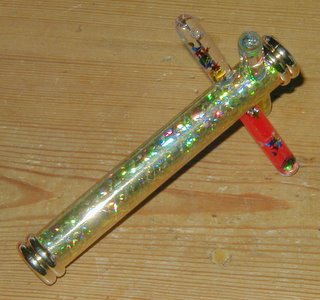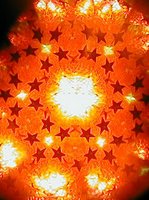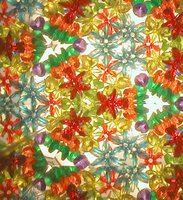 Kaleido- scopes have been very special to me since I was very young. Lately, I often looked at a kaleido- scope or two in a store, and wanted to find the ones I know are in the attic.
Kaleido- scopes have been very special to me since I was very young. Lately, I often looked at a kaleido- scope or two in a store, and wanted to find the ones I know are in the attic.The other day I finally bought one, and found that having more than a quick peek was indeed still very satisfactory, even if that particular kaleidoscope was rather cheap and not entirely pleasing.
Not having any luck looking around in the attic, I went shopping again. These were much more satisfactory, and indeed, having a variety to switch between enhances the experience.

The next day, while doing another activity quite a while after a kaleidoscope session, I realized that my mental processes were exhibiting some residual effects of the kaleidoscope viewing. I began paying more attention to the effects of the kaleidoscopes on my mind and soon realized that there was a beneficial effect on my state of mind as well.
Now some of this is surely because I am currently perseverating on kaleidoscopes. (Aspies use "perseverations," and related forms, to refer to the very intense, often compulsive, interests to which those of us with Autism Spectrum Disorders are prone.) Perseverations generally feel good. That's part of why we do them.
But I think that the patterns, with their symmetry and repetitions, are also triggering brain processes that are proving beneficial. Patterns and repetition play very central roles in autism, from the stereotypical hand flapping, to the kinds of activities, objects, or music, we are often attracted to. Not that the mainstream population doesn't also enjoy the same kinds of things, but as in so many things, we tend to be more extreme.

The "Fluid Fantasy" "X-Motion" in the picture is less than six inches long, and with the fluid-filled glitter ampules removed and packed alongside, is quite pocketable. Without the glitter ampules, you can apply a cats-eye or transparent swirl marble or superball to the object end and rotate it various directions for very satisfactory different kaleidoscope imagery.
So I pocketed it, and took it to my brother's house yesterday evening, where we gathered for a belated family Christmas with my parents.
There were ten of us, plus a dog. That many people interacting tends toward overloading me. Too much "noise," not just in the audio sense, but visual, social, and spatial as well.
Periodically through my part of the evening (I left early, but not as early as I had intended), I took out the kaleidoscope and gazed through it for a while, enjoying the changing patterns and getting the becoming-familiar effect of stimulating one part of my mind while somehow calming another. (I am reminded of the pharmaceutical treatment of hyperactivity with stimulants.)
It was successful, and I actually had a reasonably good evening.
Part of that certainly must be credited to overall improvements in both my mental state and my "tool kit" over the last year, and years, but I think beyond a doubt some of the credit goes to the kaleidoscope.
It is nice to have another tool in the toolkit.

[The red/yellow kaleidoscope images above were made with the pocket kaleidoscope with both tubes in place. All the images were made primarily for test. Now that I know it will work, there will be more!]




2 comments:
Enjoyed this post--thanks for sharing. :)
How did you manage to take such great photos of the kaleido-scopes' innards?
ummmm
i pretended the camera lens was my eyeball and poked it up against the kaleidoscope's eyepiece?
adjusted the kaleidoscope image in the LCD display until it looked reasonably good
took a bunch of pictures (taking lots and lots of pictures is often the secret to getting one or two good ones - as long as what you are doing doesn't preclude good ones)
took the images into picasa and cropped and brightened the best looking
posted the best of those
ja, and the camera was set to macro
Post a Comment